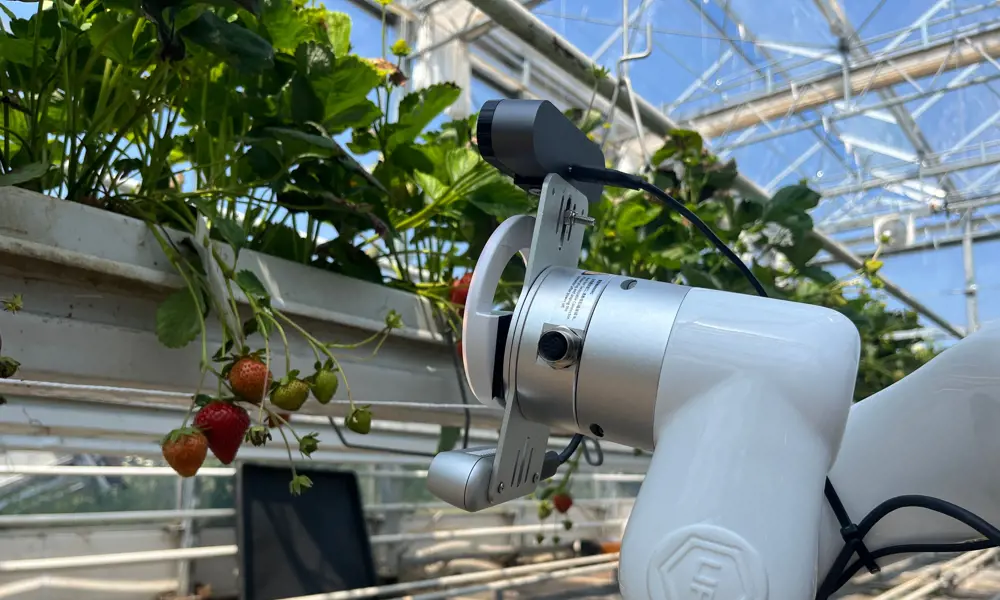
How technology is reshaping farming
💬 Shini says...
Ingenia 100 guest editor Dr Shini Somara tells us her thoughts
The diverse and inclusive uses of cutting-edge technologies in robotics are fascinating. From satellite imagery, machine learning, biotechnology and so much more, technology is essential to improving crop yields and increasing sustainable farming beyond what we are capable of at a human scale. With a planet running out of space and weather becoming more extreme, innovations such as these could ensure that less of the food we grow is not only healthier, but does not go to waste!

After one of the wettest winters on record, UK farms have struggled to cope with the heavy rain that continued through spring and long into the summer. Many farms were subject to flooding, which left crop fields under water and put the health of livestock at risk. The extreme weather, which is linked to climate change, has drastically reduced the yield of key crops such as wheat.
Alongside these pressures, farmers are facing other competing demands, including developing more nature-friendly and sustainable practices, while also keeping costs down in a tricky economic climate.
The previous Conservative government’s 2022 Food Strategy suggested that technology may have a role to play in helping farmers face such a challenge. As part of the programme, UK Research and Innovation launched a £270 million Farming Innovation Programme to support R&D projects that benefit farmers, growers and foresters in England. Examples of projects underway include new applications of satellite imagery and machine learning, as well as new vaccines for animals and biotechnologies to be used in livestock breeding. Robots, too, are making waves: along with their potential in filling in for the shortage of seasonal workers, new roles are appearing for them in pest management and targeted application of fertilisers.
"It is important to remember agritech can be implemented at any scale, large or small.”
Charlie Yorke, NFU Mutual
However, not all farmers have embraced these new technologies yet, says Charlie Yorke of the National Farmers’ Union (NFU)’s primary insurer, NFU Mutual. Results of a survey by the organisation released in January 2024 show that less than 20% of farmers have invested or plan to invest in agritech and 62% have yet to even consider it. But getting started with technology doesn’t have to mean investing significant sums in robotics and automation. According to Yorke, lower-cost, accessible solutions, such as gate sensors, RFID eartags (which can be used to track animals) or the integration of an online data administration system, can still make a huge difference to productivity. “While some large farms have invested in complex and large-scale agritech such as self-driving vehicles, alternative fuels and data-driven sensors, it is important to remember agritech can be implemented at any scale, large or small,” he says.
Send in the robots
The University of Warwick is developing technologies that may give farmers the confidence to take the plunge. In 2023, the university launched Warwick Agri-Tech to combine the facilities and expertise of WMG at the University of Warwick and its School of Life Sciences. The new centre is exploring new technologies to address issues such as labour shortages, food insecurity and biodiversity loss. “It’s rare to have access to both the manufacturing facilities we have at WMG and the 220 hectares of farmland available through the School of Life Sciences, alongside the joint expertise,” says Alicia Feledziak, Business Development Manager at WMG, High Value Manufacturing Catapult Centre. “Bringing together those two departments unlocks a massive amount of possibilities.”
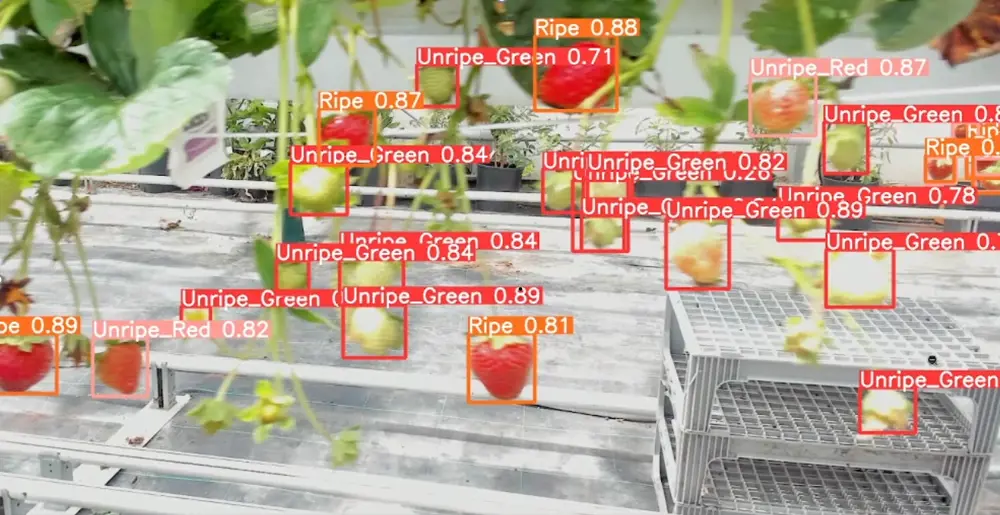
A view of Crombot’s computer vision model identifying strawberry ripeness © Warwick Agri-Tech at WMG, University of Warwick
The initiative has its roots in the ‘Crombot’ crop monitoring robot – a WMG-led project that set out to address growers’ scepticism of new technology and, most importantly, its cost. “We understand the challenges that growers are facing,” explains Emilio Loo Monardez, Lead of Warwick Agri-Tech at WMG. “Our role is to derisk the technology and create solutions that are modular, scaleable and viable for growers to adopt.”
Engineers developed a robot that could check for pests, diseases and crop ripeness – a repetitive and time-consuming but essential task. Crombot, a four-wheeled robot with a robotic arm-mounted camera, can autonomously navigate around a greenhouse to monitor crops, avoid human workers and even follow specific co-workers on command. Once strawberries and other crops are ripe, for example, the robot can also highlight which areas of the greenhouse are ready to be picked.
WMG engineers have also made use of ‘Spot’, the autonomous four-legged robot dog developed by Boston Dynamics that went viral in 2016, and have adapted it for use in agriculture and horticulture. Spot can walk up and down steps, over heating rails and other obstacles as well as tackle muddy fields with ease, which have all proved beneficial in handling a variety of greenhouse and outdoor environments. But Feledziak points out that – similar to Crombot – its main role was in inspection, with the team building algorithms to monitor variables such as pests or the ripeness of fruits. “The real research is happening in the brain of the robot and how that can be applied to different purposes in the agricultural space,” she explains.
“We understand the challenges that growers are facing. Our role is to derisk the technology and create solutions that are modular, scaleable and viable for growers to adopt.”
Emilio Loo Monardez, Warwick Agri-Tech at WMG
Autonomous robots such as Crombot and Spot are central to a more data-led approach to improving crop yield. As well as using sophisticated cameras and image-processing technology to accurately monitor when fruit and vegetables are ready for harvest, they can reduce chemical use. Robots can identify the exact locations where herbicides and pesticides are needed – and when – so that growers can apply the products directly rather than spraying a whole crop and risking contamination.
For example, engineers at Warwick are developing an AI-based weed-control robot that promises to cut the need for herbicides by over 90% while improving soil health and biodiversity. Currently, when growers apply herbicides, they are sprayed over everything – the run-off is absorbed into soil, killing biodiversity, and also washes into streams and rivers when it rains, polluting waterways and even ending up in drinking water. The APSA (Autonomous Smart Spot-Precision Application of Herbicide) project uses a platform with computer vision to look for weeds, using AI-enabled recognition to identify them. A robot can then distribute targeted doses of weedkiller where needed, so that there is no excess run-off. This approach can also encourage growers to use more sustainable bioherbicides and bioprotectants. These are more environmentally friendly but, because of their lower potency, need to be delivered more precisely to have a comparable effect. “There is a
huge amount of pressure to reduce chemical use in agriculture and make processes more sustainable,” adds Loo Monardez. “With this algorithm, we’ll start with herbicides and then it can be transferred to other weed-eliminating solutions such as laser and electric pulse.”

Computer vision software identifies different species of weed (left) and the autonomous spot application of herbicide robot in action (right) © Warwick Agri-Tech at WMG, University of Warwick
Another project at Warwick is using automated monitoring to tackle spider mites in tomato crops. As a robot travels along and inspects the rows of plants, a hyperspectral camera monitors the leaves. Hyperspectral imaging gathers detailed information about an object’s composition and characteristics, in this case picking up changes in how the leaves reflect light. Changes in reflection indicate damage caused by mites, which are small and hide on the underside of the leaves – extremely difficult for the human eye to see and not a viable position for a camera. The monitoring process continuously feeds data on pest levels to a system that ensures that a second line of defence – possibly in the form of a natural fungus-based bioprotectant – is brought into play at exactly the right time and applied only where required.
Elsewhere, researchers at the University of Loughborough are also working on an AI-enabled navigation system for use in two projects that are aiming to improve the efficiency of fruit picking in the UK. The £4.5millon Precision Orchard Management for the Environment (POME) project is a four-year venture that will digitally examine and scan fruit trees in fine detail to generate precision-dosing maps for blossom, fruit thinning, fertiliser application, growth regulators, pest controls, and fungicides, while producing more accurate yield forecasts for growers. Its Area-H project has developed a navigation system to help support agricultural autonomous robots in the field. Both projects have received funding from DEFRA and Innovate UK.
Reducing land use
Autonomous and AI-enabled technologies, like those emerging from Warwick and Loughborough, are designed to work within an environment that resembles a traditional farm. However, engineers have also developed approaches that are transforming the ways in which crops are grown.
Often touted as a way to boost productivity while reducing land use and therefore environmental impact, vertical farms use soil-free growing techniques and stack crops in specially designed beds and trays. As well as minimising the need for water, fertiliser and pesticides, they make carefully controlled use of artificial lighting and climate control.
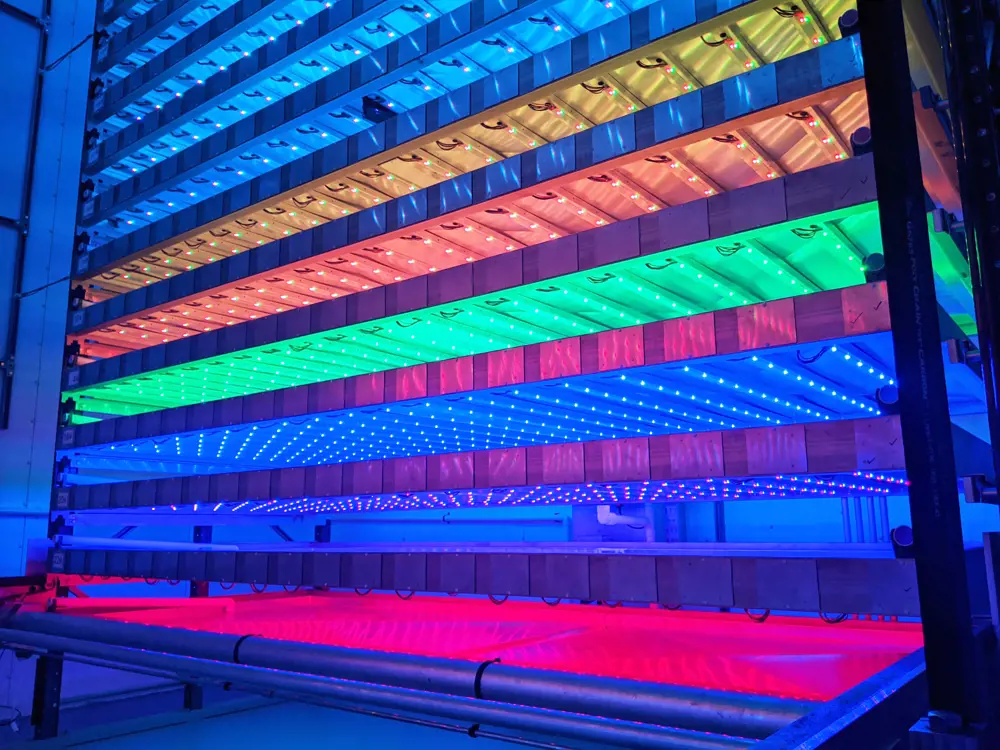
Intelligent Growth Solutions' Growth Towers © Intelligent Growth Solutions
Edinburgh-based Intelligent Growth Solutions’ (IGS) demonstration facility in Dundee is equipped with models of its Growth Tower fully automated platform. Its modular system of stacked trays is irrigated by a central mechanism that employs ebb and flow hydroponic technology – similar to tides rising and falling along coastal areas and estuaries – to pump recycled, nutrient-rich water to each plant. Meanwhile, LED light strips underneath each tray illuminate the plants on the tray below. And the whole system operates hand in hand with HVAC (heating, ventilation and air conditioning) controls to achieve optimal humidity, with condensed water collected, captured, cleaned, and recycled.
The app-controlled environment can grow a broad range of crops, including salads, leafy greens, brassicas, edible flowers, and even fruiting crops such as chillies. IGS claims each unit can yield 20 tonnes of crop in just 40 square metres of floor space rather than an outdoor plot of a hectare or two – roughly the size of two rugby union pitches. Its technology has already been exported globally, to places such as the US, and the company’s ambitions continue growing.
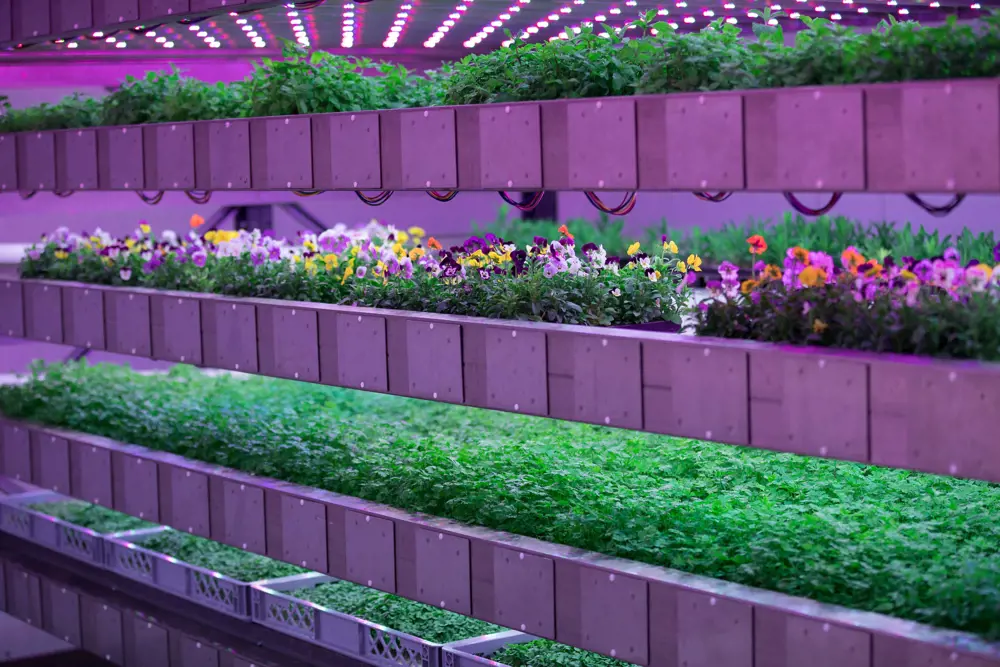
Peppermint, violas, parsley, and micro kale grow in one of IGS’s Growth Towers © Intelligent Growth Solutions
At the COP 28 UN climate change conference, IGS showcased a future ‘gigafarm’ that aims to incorporate hundreds of 12-metre-high Growth Towers. The plan is for the gigafarm to be built on an 87,000 square-metre site in Dubai, where it will grow more than 3,000 tonnes of produce per year. IGS says that it will be 98% more water efficient than growing crops in a field. The facility is expected to be fully functional by 2026 and will support the UAE’s move towards decarbonising food production.
IGS’s partner on the project is Dubai-based ReFarm – a group of companies that is driving forward the UAE’s first zero waste food security initiative. The gigafarm will also recycle more than 50,000 tonnes of food waste, turning it into a fertiliser and soil that can help crops grow in extreme climates. Onsite, black soldier fly larvae will convert food waste into a biomass that is rich in proteins and fat, and byproducts will include organic compost, animal feed for replacing unsustainable fish meal and soy oil, and water for use in the vertical farming towers. The onsite technologies will also recover up to 90% of ammonia sulphate from wastewater for use in plant fertilisers.
IGS says that its gigafarm will be 98% more water efficient than growing crops in a field.
Closer to home, IGS is part of the V-FAST (Vertical Farms and Storage) consortium, a group of UK companies that has earmarked sites between Dumbarton and Dundee in Scotland for a series of vertical farms, powered by renewable energy. The low hills of the region are ideal for an approach that combines vertical farming with local renewable energy generation and energy storage, often within the same footprint and on lower quality land that is not suitable for traditional farming.
One of the main challenges – for all vertical farms – is the cost of energy. Co-located renewable generation helps, but intermittent availability of wind and solar power means some form of storage is needed to provide the 8 to 12 hours of backup required for vertical farming.

Diagram showing how RheEnergise’s High-Density Hydro system works © RheEnergise
Part of the V-FAST solution is a high-density hydro storage system from partner RheEnergise that provides grid stability while meeting the predictable base energy demand of a vertical farm. The 10 megawatt and 50 megawatt systems operate on a similar principle to traditional pumped hydroelectric storage – where two water reservoirs at different levels generate power as water moves between them via a turbine. But RheEnergise’s system uses a fluid with a density two and a half times that of water, which means it can be installed on small hills rather than tall mountains. Fluid is pumped to the highest storage tank at times of low energy demand using power from renewables or cheap electricity from the grid. As conditions change, the fluid is released and passes through turbines as it descends, generating electricity.
Subject to site investigations, planning and financing, the first V-FAST project could be completed within the next two to three years. With 10,000 cubic metres of vertical farming floor area and 80 megawatt hours of energy storage, it could produce 20 to 30 times as much food that could grow in open fields of the same size.
Engineering plant genes 🌱
Changes to plants' structures are helping to combat disease
Manipulation of plant and animal microbiomes is helping tackle diseases that can have a significant effect on crop yields. In this emerging branch of biological engineering, scientists are looking for an alternative to pesticides to control bacterial blight. Researchers at the University of Southampton, with colleagues from China and Austria, achieved a first recently when they successfully boosted the prevalence of ‘good’ bacteria that protect the plant from disease.
The team identified one specific gene found in the lignin biosynthesis cluster of the rice plant, which is involved in shaping its microbiome. Lignin is a complex polymer found in the cell walls of plants – the biomass of some plant species consists of more than 30% lignin.
When they deactivated this gene, there was a decrease in the population of certain beneficial bacteria, confirming its importance in the makeup of the microbiome community. Overexpressing the gene – essentially making too many copies of it – caused it to produce more of one specific type of metabolite (a small molecule produced by the host plant during its metabolic processes). This increased the proportion of beneficial bacteria in the plant microbiome.
When the team exposed these engineered plants to Xanthomonas oryzae (a pathogen that causes bacterial blight in rice crops) they were substantially more resistant to it than wild-type rice.
Dr Tomislav Cernava, Associate Professor in Plant–Microbe Interactions at the University of Southampton, predicts that the technique could have a range of applications: “We’ve achieved this in rice crops, but the framework we’ve created could be applied to other plants and unlock other opportunities to improve their microbiome. For example, microbes that increase nutrient provision to crops could reduce the need for synthetic fertilisers.”
Security and sustainability
The use of robotics and AI in crop monitoring and the adoption of vertical farming techniques are a step in the right direction to addressing the pressing challenges of modern agriculture. The UN says that global food production from plants and animals must increase by 70% by 2050 to meet demand, but it is already responsible for nearly a third of carbon emissions as well as significant deforestation.
As Monardez points out these challenges are “bigger than just engineering” but he suggests that multidisciplinary approaches, which combine engineering, plant science and biology, can help the agricultural sector enhance food production while adhering to sustainability goals. The pioneering efforts of UK engineering, demonstrated by initiatives such as Warwick Agri-Tech and IGS, already point to technology and innovation’s potential to lead the way.
Contributors
Alicia holds an integrated master’s degree in mechanical engineering and has industrial experience in manufacturing technology development and factory of the future technologies across both maritime and aerospace. Alicia is now responsible for driving the strategic growth of Warwick Agri-Tech, developing an entity capable of derisking and accelerating innovation for industry for the future of farming.
Emilio has over 15 years of experience in industrial engineering, automation, robotics, and lean manufacturing. Emilio led the creation of Warwick Agri-Tech, and alongside his colleagues, continues to develop its strategy, collaborating with businesses and organisations to support sustainable production of food, aiming to contribute to a stable, sustainable, global food system.
Dominic Lenton
Author
Keep up-to-date with Ingenia for free
SubscribeRelated content
Food & agriculture
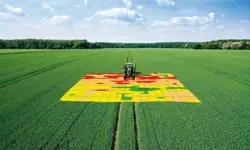
Precision farming
Technologies such as global positioning systems and guided vehicles are being developed to create an era of precision farming. Professor Richard Godwin FREng explains how these initiatives can combine accuracy and control of field operations leading to increased efficiency and yields.
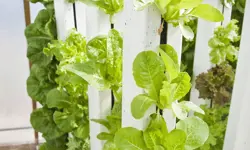
Farming straight up
Hydroponics, growing plants without soil in nutrient-enriched water, is a technique that has been used in some form for centuries. As the global population grows and food security is threatened, its faster growth and larger yields have become increasingly important.
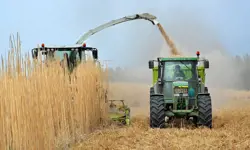
What role for biofuels in low-carbon UK transport?
Biofuels have a role to play in meeting the UK’s climate change commitments. Sustainable Chemical Engineering Professor Adisa Azapagic FREng sets out why biofuels made from wastes and by-products in different sectors are particularly important to these efforts.
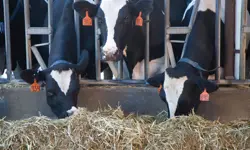
The automation of dairy farms
Robotic milking is not a new innovation, but the systems are increasingly being adopted by UK dairy farms. Science writer and broadcaster Geoff Watts learned from John Baines, Technical Director at Fullwood, how these systems are being engineered to do more than just milk cows.
Other content from Ingenia
Quick read

- Environment & sustainability
- Opinion
A young engineer’s perspective on the good, the bad and the ugly of COP27

- Environment & sustainability
- Issue 95
How do we pay for net zero technologies?
Quick read

- Transport
- Mechanical
- How I got here
Electrifying trains and STEMAZING outreach

- Civil & structural
- Environment & sustainability
- Issue 95